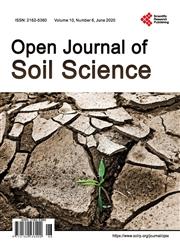In-Field Corn Residue Management for Bioenergy Use: Potential Effects on Selected Soil Health Parameters
引用次数: 0
Abstract
In the U.S. biofuel industry is using corn (Zea mays L.) residue mix (CRM) consisting of corncob and stover for cellulosic ethanol and biogas production. The field storage method left different depths of CRM on the field after its removal, where negative effects on plant growth were observed. The objective of this study is to evaluate the CRM effect on selected soil health indicators. The field study conducted with four different depths of CRM, two tillage systems (no-till (NT) and chisel plow (CP), and three nitrogen (N) rates (0, 180, and 270 kg⋅N⋅ha−1) in a randomized complete block design with split-split arrangements in three replications in a continuous corn system from 2010 to 2012 at the Agronomy Research Farm at Iowa State University. The findings of this study showed a negative effect on soil organic carbon (SOC) change across all treatments at 0 - 15 cm (−0.35 to −0.03 Mg⋅ha−1⋅yr−1), while at 15 - 30 cm there was an increase in SOC rate (0.13 to 0.40 Mg⋅ha−1⋅yr−1) after 2-yr. In addition, soil aggregate-associated C of macro-aggregates decreased by 8%, while micro-aggregates increased by 2%. Soil microbial biomass carbon (MBC) across tillage and N rates for 2.5 & 7.5 CRM treatments increased by 14% in June to July 2011, while in 2012 increased by 9%. However, at the 15 cm soil depth, soil bulk density (ρb), soil penetration resistance (SPR), and soil pH showed no significant differences among CRM treatments. The findings of this study showed that in-field CRM management can affect certain soil health parameters in the short term.玉米秸秆生物能源利用的田间管理:对选定土壤健康参数的潜在影响
在美国,生物燃料行业正在使用由玉米芯和秸秆组成的玉米(Zea mays L.)残渣混合物(CRM)生产纤维素乙醇和沼气。田间储存方法在去除CRM后在田间留下不同深度的CRM,观察到对植物生长的负面影响。本研究的目的是评估CRM对选定土壤健康指标的影响。2010年至2012年,在爱荷华州立大学农学研究农场的连续玉米系统中,采用四种不同深度的CRM、两种耕作系统(免耕(NT)和凿犁(CP)以及三种氮(N)施用率(0、180和270 kg·N·ha−1)进行了田间研究。这项研究的结果表明,在0-15厘米(-0.35至-0.03 Mg·ha−1·yr−1)的所有处理中,土壤有机碳(SOC)的变化都会产生负面影响,而在15-30厘米的处理中,2年后SOC的变化率会增加(0.13至0.40 Mg·公顷−1·r−1)。此外,土壤团聚体相关的宏观团聚体C降低了8%,而微观团聚体增加了2%。2011年6月至7月,2.5和7.5 CRM处理的土壤微生物生物量碳(MBC)在耕作和施氮率方面增加了14%,而在2012年增加了9%。然而,在15cm土壤深度下,CRM处理的土壤容重(ρb)、土壤渗透阻力(SPR)和土壤pH值没有显著差异。本研究结果表明,田间CRM管理会在短期内影响某些土壤健康参数。
本文章由计算机程序翻译,如有差异,请以英文原文为准。
求助全文
约1分钟内获得全文
求助全文

 求助内容:
求助内容: 应助结果提醒方式:
应助结果提醒方式:


